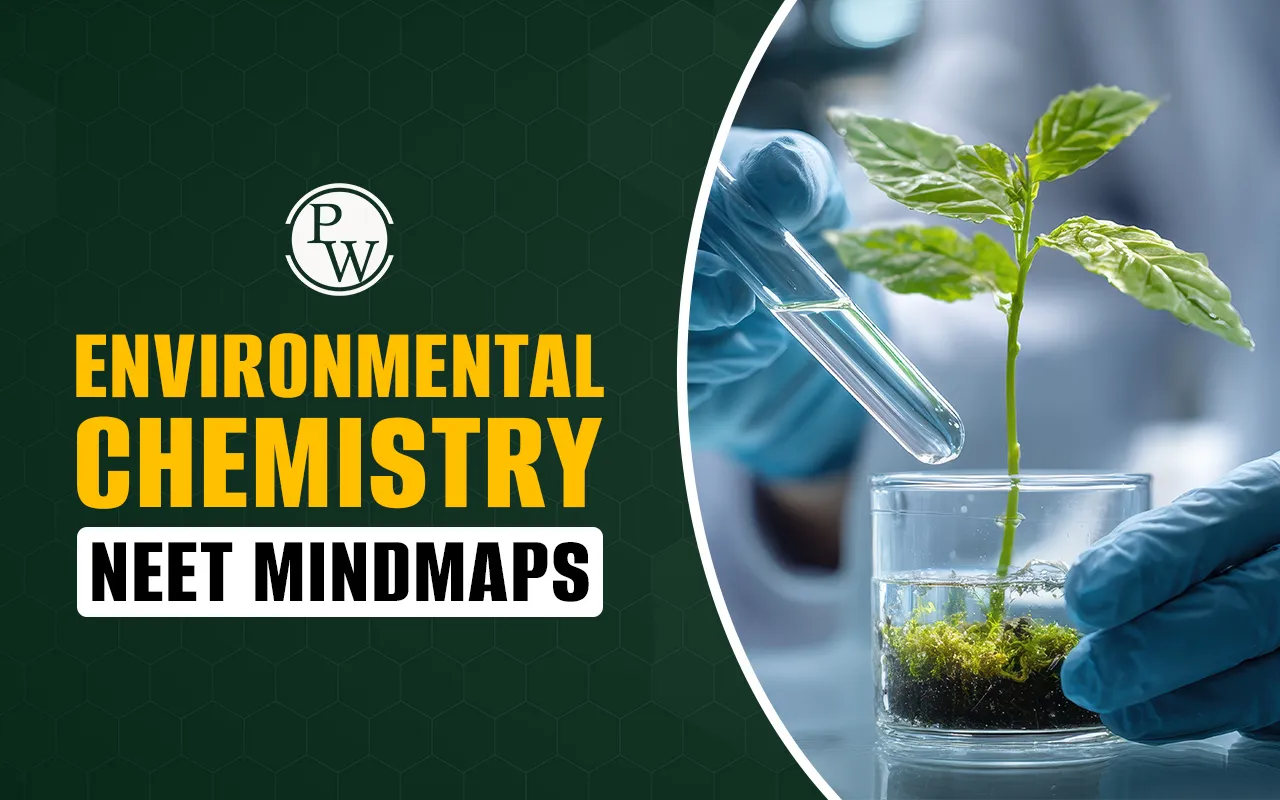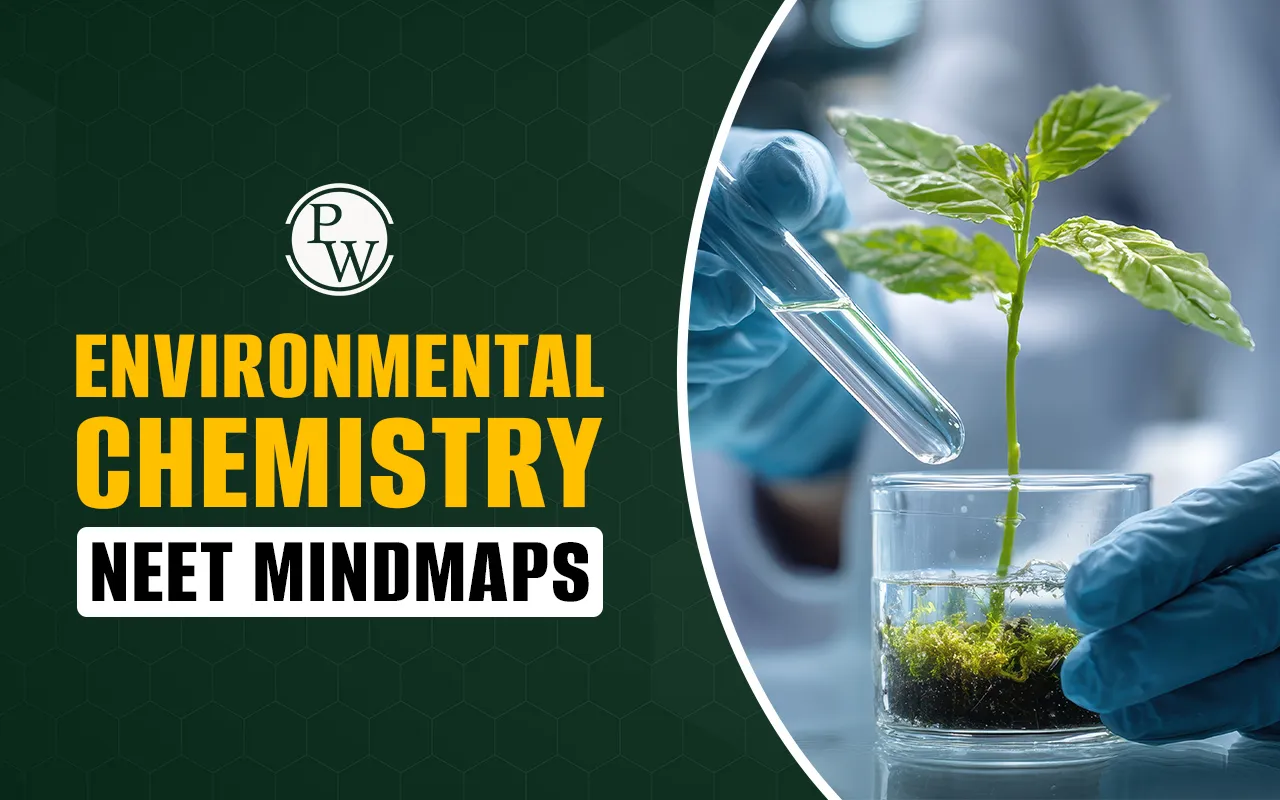

Environmental Chemistry NEET Mindmap: Environmental Chemistry is a short yet high-yield chapter in NEET Chemistry. It covers the chemical basis of environmental issues such as air, water, and soil pollution, as well as their causes, effects, and control measures. Despite its brevity, this chapter frequently appears in the NEET exam. From this, mostly direct theory-based and application questions appear.
Environmental Chemistry NEET Mindmaps organize the entire chapter into a visual, one-page summary. This allows students to revise pollutants, reactions, environmental cycles, and preventive measures at a glance. Environmental Chemistry NEET mindmap PDF is useful for last-minute preparation, ensuring no important detail is missed during revision.
Environmental Chemistry NEET Mindmap Notes
Environmental Chemistry NEET mindmap notes combine the chapter into key sections for quick recall:
|
Environmental Chemistry NEET mindmap notes |
|
|
Topic |
Key Points |
|
Air Pollution |
Caused by oxides of sulfur, nitrogen, carbon monoxide, unburnt hydrocarbons, and particulates. |
|
Water Pollution |
Caused by heavy metals, pesticides, detergents, and sewage. Leads to eutrophication. |
|
Soil Pollution |
Results from industrial waste, plastics, pesticides, and fertilizers. |
|
Greenhouse Effect & Ozone Depletion |
CO₂, CH₄, and CFCs trap heat; CFCs cause ozone depletion. |
|
Waste Management |
Biodegradable vs non-biodegradable waste; 3Rs principle (Reduce, Reuse, Recycle). |
|
Analytical Techniques |
COD, BOD used for water quality testing. |
Environmental Chemistry NEET Mindmap Formulas
While this chapter includes theory, some Environmental Chemistry NEET Mindmap Formulas are important:
|
Environmental Chemistry NEET Mindmap Formulas |
|
|
Concept |
Formula / Value |
|
Biological Oxygen Demand (BOD) |
Amount of oxygen required by microorganisms to decompose organic matter in water. |
|
Chemical Oxygen Demand (COD) |
Oxygen required to oxidize organic and inorganic pollutants chemically. |
|
pH scale |
pH=−log[H+]\text{pH} = -\log [H⁺]pH=−log[H+] |
|
Ozone formation |
O2+UV→2OO_2 + UV \rightarrow 2OO2+UV→2O, then O+O2→O3O + O_2 \rightarrow O_3O+O2→O3 |
|
Pollutant concentration units |
ppm (parts per million), mg/L for water pollution. |
Environmental Chemistry NEET Mindmap PDF
Environmental Chemistry NEET mindmap PDF is a compact revision aid that summarizes air, water, soil pollution, their sources, and control measures. It highlights greenhouse effect, global warming, and ozone depletion with key reactions. It also provides access to COD, BOD, and pollutant concentration values.
Since the chapter is theory-based, the PDF version is especially effective for last-minute revision before the NEET exam. You can download the Environmental Chemistry NEET Mindmap PDF from below:
Environmental Chemistry NEET Mindmap PDF
Environmental Chemistry NEET Mindmap Practice Questions
Practice is important when it comes to scoring well in NEET.Environmental Chemistry NEET Mindmap Practice Questions tests direct facts and applications:
-
Identify the type of smog formed by NO₂ and hydrocarbons in sunlight.
-
Explain the role of CFCs in ozone depletion.
-
Differentiate between BOD and COD with examples.
-
State pollutants causing eutrophication in lakes.
-
Which gases are responsible for the greenhouse effect?
By practicing these along with the mindmap PDF, you can strengthen memory and improve accuracy in NEET Chemistry.
Tricks to Revise Environmental Chemistry with Mindmaps
Environmental Chemistry can feel like memorizing facts, but with simple tricks, revision becomes easier:
-
Group pollutants into categories (air, water, soil) to avoid mixing them up.
-
Use mnemonics for greenhouse gases (e.g., "Can Men Feel Cold?" → CO₂, CH₄, Fluorocarbons, CFCs).
-
Relate smog to Delhi winters, or ozone depletion to skin cancer risks.
-
Remember photochemical smog is oxidizing, unlike classical smog.
-
Go over BOD, COD, and pH formulas daily in the last week before NEET.
-
Just before the exam, rely on the PDF to recall pollutants, reactions, and control methods in minutes.
